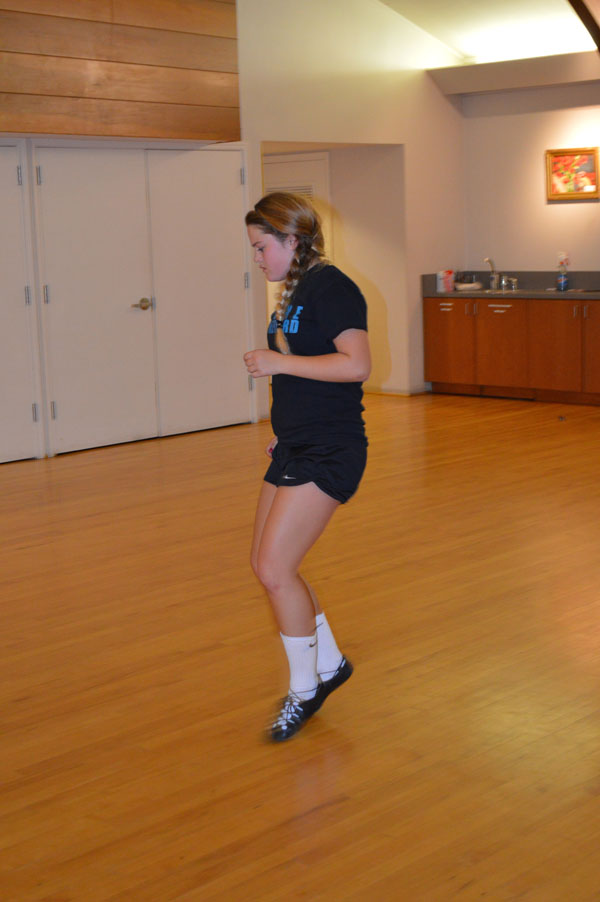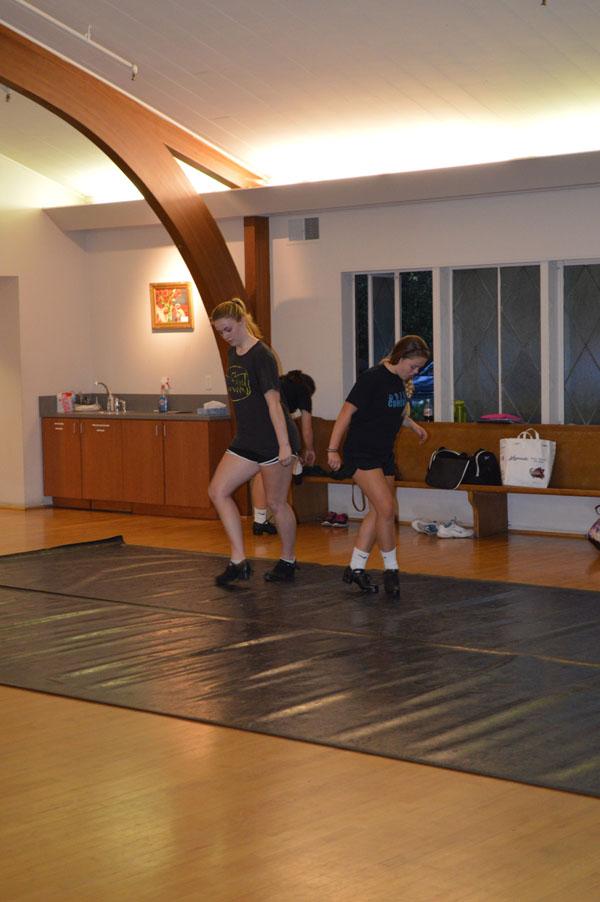
The tapping of the dancers’ feet against the wooden floor echoes about the room, reverberating off the walls and bouncing every which way. Traditional Irish reel-style music hums lively from an iPod player against the wall, emanating a quick, steady beat and setting the pace for the dancers. The sound increases as Palo Alto High School sophomore Larkin McDermott flies by, springing athletically off the hard floor. Other dancers, including junior Kristen Carey, glide across the long black mat lining the floor, arms at their sides, moving only their legs and feet to the steady rhythm of the music. A golden glow spills through the open windows and into the cool night as the girls practice, floating across the floor with skill and concentration.
McDermott and Carey have been involved in Irish dancing for more than half of their childhood, and continue to dance at a highly competitive level, practicing at the Greene-Comerford School of Irish Dance in San Jose.
Irish dance, age-old in origin and popularized across the globe in 1994 by the famed show Riverdance, combines a diverse mix of complex steps, performed solely by the lower body. Arms are generally held still at the sides of the body, allowing the dancer to focus on precise foot movements, wearing either soft or hard shoes.
According to Carey, this contained lower body movement is what differentiates Irish dance so clearly from other styles of dance.
“Having your arms completely still as well as your entire body is something that judges look for,” she says. “Carriage is a major factor in Irish dancing that a person watching might not realize the difficulty of.”
When performing in hard shoes, which feature heavy tips and heels made of fiberglass, Carey compares the rhythm and sound to that of tap dance.
“The rhythm is similar to that of tap, but in many ways it’s completely different,” she explains. “An Irish dancer has to focus on crossing over and turning out their feet along with about a million other things as well.”
Carey and McDermott, along with former Irish dancer, junior Maeve Lavelle, were influenced by their families and friends to take up Irish dance.
“All my family is from Ireland and still lives there,” Lavelle says. “My mom [danced], and I think I saw Riverdance or something and was like, look how cool that is, and so that probably got me into it as well.”
The three have all competed at the national level in the North American Irish Dance Championships, some more than once.
“The [championships] this past year, I was the only one who went,” Carey says, “but the year before that, the three of us went, and we were all on the same team.”
Dances are practiced and performed to traditional Irish reel-style music, combining an eclectic mix of Celtic instruments, including a variety of pipes, flutes, and light percussion beats. Carey says for each dance in a competition, the judges choose the music ahead of time, to which the dancers then prepare and practice.
“Unlike some other dance styles, we don’t chose the music we dance to,” Carey says. “We are assigned different dances depending on our age.”
Competitions feature a live musician who accompanies the different dances.
To keep pace with the music, Irish dancing combines a myriad of unusual steps, requiring considerable precision and accuracy of movement. Carey says one of the most difficult aspects of Irish dancing is putting the moves and steps together to create a fluid, seamless dance.
“One move that is hard for me is called a ‘rock,’ which is where one locks their ankles and literally rocks back and forth, shifting the weight from one ankle to the other,” Carey says. “It looks like a simple move but it destroys your ankles.”
To keep up their skills and prepare for competitions, McDermott and Carey practice four to five days a week at Greene-Comerford. In addition to numerous team practices, the two both make time to train independently.
“If we don’t have class, I’m either working out to build stamina or I’m practicing,” McDermott says.
According to McDermott and Carey, practice time is crucial, as missing even one day could offset a dancer’s timing and skills.
“If you take a day off, you set yourself back stamina-wise because it takes so much stamina to be able to get through everything,” Carey says. “You still have to do something, even if it’s just stretching or you know, doing some ab work.”
Because dancing requires such dedication, Carey devotes all of her after school time to dancing and school work.
“I basically don’t do anything else,” she says. “My day consists of waking up, going to school, going back, doing my homework on the way to dance. Sometimes I’ll wake up early before I come to school to get an extra practice in.”
According to McDermott, one of the perks of Irish dancing is getting to wear elaborate costumes and makeup for performances.
“I love dressing up,” she says. “I love the wigs, I love the makeup, I love the costumes.”
Since the development of Irish step dancing in the mid-1700s, Irish dancewear has deviated considerably from the traditional attire, which often featured plain skirts, blouses and sashes. Although womens’ Irish dance costumes still incorporate traditionally Irish elements, such as Celtic embroidery and lace, today’s Irish dance dresses are replete with modern flair, often in flashy colors with sequins, jewels, and fringe. Today’s dancers are even required to wear abundantly curly wigs, a lasting product of the big-haired 1980s.
Carey explains that a unique costume is something that judges notice, as it makes a dancer stand out from the rest of the group.
“You can walk on stage, and you have to look the part,” Carey says. “You have to be the part, that’s what our teacher tells us, you have to present yourself. The way you walk on stage before the music even starts [is important].”
“It’s a pageant,” McDermott adds. “You have to look confident with your head up, smiling.”
Another aspect of performances is the stage makeup dancers are required to wear, often consisting of heavy foundation, blush, and eye shadow. Carey remembers waking up at 5 a.m. on competition days to apply her makeup, which she then had to wear until midnight that day.
“Up close, you feel like you are wearing a lot of makeup, but if you see it on stage, it looks normal,” McDermott explains.
Dancers are also required to get spray tans for solo performances, another technique used to make dancers more visible in the bright stage lighting. Carey finds the fake tan amusing, as it doesn’t reflect traditional Irish culture.
“We have to get fake spray tans on our legs and put loads of bronzer on our face even though the typical Irish person is light skinned with freckles,” Carey says. “But it’s an aspect of the sport that’s evolved and we have to do it to stay modern.”
While Carey and McDermott enjoy competing in Irish dance, they find some aspects of the competition environment vexing.
“For me, you put in countless hours for months leading up to [the competition], and you get two minutes on stage to show everything that you’ve done,” Carey says. “You could get up and fall, you can be off time, and you’re completely tossed aside and all those months were for nothing. That’s the part for me that’s the most nerve-wracking, when it’s like every second counts, and you can’t mess up or else you’re [finished].”
However, Carey explains that these complications have encouraged her to work harder to improve her dancing and skills.
“It’s a lot of work, it’s not easy,” she says. “But when you’re at a competition, and it goes the way that you want it, that feeling is like, you can’t even, I don’t even know how to describe it, It’s like, I mean I was like crying out of happiness.”
McDermott agrees.
“It makes you feel like you’re on top of the world,” McDermott says. “You don’t have to win, but if you do the way you wanted to or better, then you just, you feel so good.”
According to Carey and McDermott, those who have not heard of Irish dancing before may be surprised by how many people actually participate in this unique sport.
“I think people are sometimes surprised with how big the sport actually is,” Carey says. “It’s an entire world that the majority of people don’t know exists.”
However, when people do discover the world of Irish dancing, they can’t help but feel captivated by it.
“It’s just so fun to be able to tell people I do Irish dancing and to hear their reaction be so surprised and just say ‘wow,’” McDermott says. “It’s such a unique sport.”



